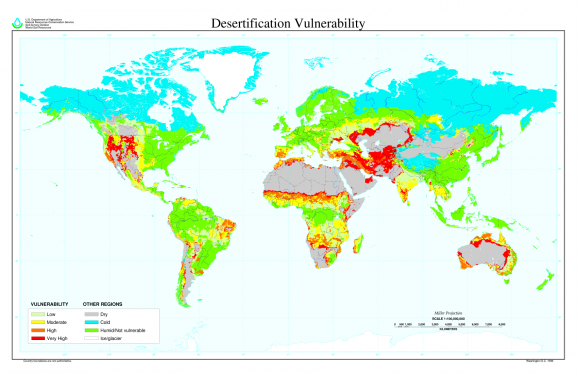Tumbleweed Robot May Help Stop Desertification
This article is more than 2 years old
 All you ballad writers and singers, get ready to croon. Drifting along with the tumbling tumbleweeds is a robot designed to help stop the spread of deserts.
All you ballad writers and singers, get ready to croon. Drifting along with the tumbling tumbleweeds is a robot designed to help stop the spread of deserts.
Didn’t know deserts were a problem? Apparently, desertification, the process by which dry land becomes arid and unable to sustain any water, plants, or animal life, has become a rapidly worsening problem over many areas of the globe. Scientists know that climate change, mining, overpopulation, deforestation, and widespread agricultural proliferation all contribute to it in some measure to desertification, but they don’t understand precisely how it works. Part of that gap in information is because it’s difficult to gather data from and about deserts, especially from their dry and dangerous depths. Shlomi Mir, a Jerusalem-based industrial designer, has developed a robot to help solve the data-harvesting problem, and perhaps help make a dent in the problem of desertification itself. Appropriately enough, the robot is called Tumbleweed, for obvious reasons.

Tumbleweed is an autonomous system designed to operate for a number of years in the desert. Mir believes that Tumbleweed can travel thousands of miles via wind power, gathering data about the land conditions. Autonomous systems that travel on land are notoriously difficult (unless, perhaps, you’re Boston Dynamics).
Tumbleweed represents a departure from conventional terrestrial robots given that it has no legs and moves by rolling. One of the advantages is that Tumbleweed can’t trip and fall, and it has no need to balance. It’s made out of steel and uses tension to react to its wind-blown path. As it waits to hitch a ride on a gust of wind, it flattens out like a plate, and then can use its sail to harness the wind to blow it in the right direction. Its kinetic generator converts its motion to power for its sensors, motor, and computer.
Initially, Mir planned to have Tumbeweed distribute grass seeds in places particularly susceptible to desertification, which would help protect against erosion. But simply stuffing seeds into the Tumbleweed and having it drop them along the way wasn’t going to result in grasses and greenery: “It’s much more complicated than that,” Mir says, embracing the reality that gathering data from otherwise inaccessible desert locations will help scientists in all sort of ways. Instead, he’s revising his original design and working on making a number of smaller and more adroit robots that will eventually be able to explore the desert in pairs or teams and record what the others are doing. Eventually, Mir hopes that they’ll be able to piece together a 3-D map of a sand dune and the winds that travel along its surface, giving scientists insights into how dunes move and spread.
NASA has shown interest in the tumbleweed design to get data from hard-to-reach areas of Mars that conventional rovers can’t access. Given the winds and the decreased gravity on Mars, a tumbleweed robot might look more like a basketball, but if scientists can figure out a way for the tumble-bot to carry all its instruments and some kind of power source, we might see a version of the Tumbleweed hanging out with Curiosity and Opportunity sometime in the future.












